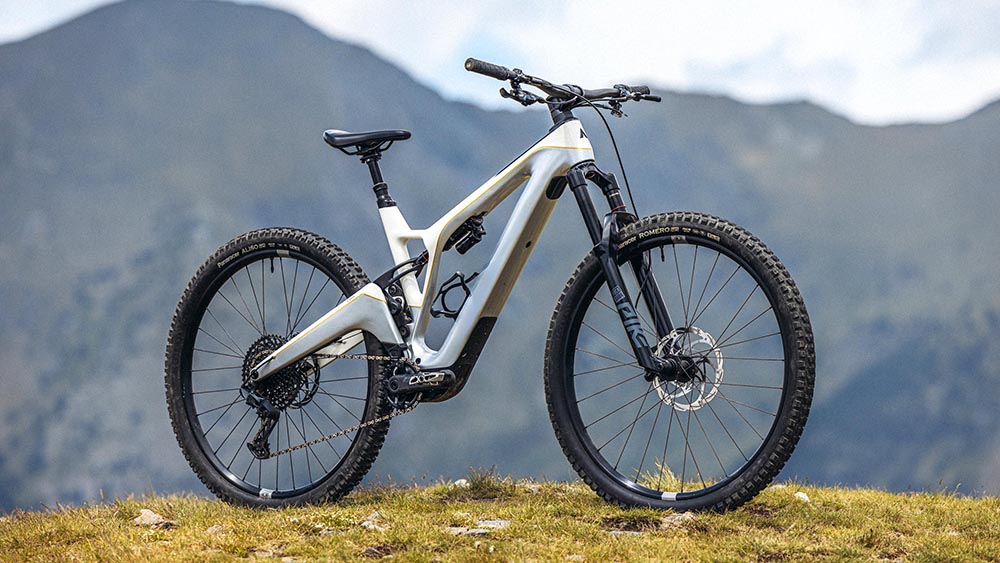Introduction to Electric Mountain Bikes
Interested in buying an electric mountain bike but not quite sure where to start? In this article, we’ll tackle some of the most common questions, such as what an electric mountain bike is, how they operate, cost, expected mileage on a single charge, and more. After reading this guide, you’ll be equipped with the basics to make a confident decision and walk away happy. For a more detailed discussion, be sure to consult a bike professional at your local REI shop or other bike shop.
What is an electric mountain bike (e-MTB)?
At its core, an electric mountain bike (e-MTB for short) is a mountain bike with a rechargeable battery that powers a small electric motor. This motor and battery unit provide extra help when you pedal, making it easier to climb steep hills and ride long distances. Electric mountain bikes share many similarities with non-electric mountain bikes, including the same components such as wheels, tyres, drivetrain, brakes, and suspension. From a distance, it is often difficult to distinguish an electric mountain bike from a non-electric mountain bike.
How electric mountain bikes work
 Most electric mountain bikes come with a small mid-drive motor mounted near the bottom bracket of the bike (where the crank arm attaches to the bike frame). The motor sends power directly to the chainring. Most electric mountain bike batteries are integrated into the downtube of the bike frame, some are mounted externally. This motor provides additional assistance to help you move forward when you pedal. Most quality electric mountain bikes offer various levels of riding modes, from eco to max assist, and can be easily adjusted dynamically using a handlebar-mounted remote control.
Most electric mountain bikes come with a small mid-drive motor mounted near the bottom bracket of the bike (where the crank arm attaches to the bike frame). The motor sends power directly to the chainring. Most electric mountain bike batteries are integrated into the downtube of the bike frame, some are mounted externally. This motor provides additional assistance to help you move forward when you pedal. Most quality electric mountain bikes offer various levels of riding modes, from eco to max assist, and can be easily adjusted dynamically using a handlebar-mounted remote control.
Who are electric mountain bikes best for?
Everyone! Electric mountain bikes aren’t just for beginners or experts. They are a versatile option for riders of all skill levels. For novice riders, electric mountain bikes offer the opportunity to explore more trails, ride longer distances and keep in touch with more experienced friends. For experts, these bikes add an exciting dimension to technical climbs and give them more time to enjoy exciting descents. After all, isn’t that the best part of mountain biking? Additionally, electric mountain bikes are an excellent choice for riders with busy schedules, as they offer a convenient way to squeeze in their duties.
Are electric mountain bikes good to ride?
Yes! If you can ride a mountain bike (sometimes called an analogue bike), then you can ride an electric mountain bike. If you’re initially intimidated by the idea of a bike with a motor and extra power, we recommend starting with the lowest level of help. As you gain confidence and experience, you can move on to bikes with more help. Get more tips in our article How to Ride an Electric Mountain Bike.
Benefits of electric mountain biking
Electric mountain bikes make steep and challenging climbs more enjoyable by providing motorised assistance.
They are perfect for individuals who are pressed for time, allowing riders to cover more miles in less time.
Electric mountain bikes create an inclusive experience that effectively bridges the fitness gap between beginners and experts.
Disadvantages of Electric Mountain Bikes
While electric mountain bikes offer many advantages, they also have some disadvantages, including:
Electric mountain bikes are significantly heavier than non-electric mountain bikes, often weighing 10 to 20 pounds more.
They tend to be more expensive, typically $2,000 more than comparable models without motors.
Loading an electric mountain bike onto a vehicle can be more challenging due to the added weight, and the bikes often require bike racks specifically designed to handle the load. For more information, see this article on how to choose an e-bike frame.
 How far can I ride on a single charge?
How far can I ride on a single charge?
It depends. Variables such as the level of assistive equipment you use, the steepness of the terrain, the weight of the rider (and even the outdoor temperature) all play an important role in battery life and range. That said, most high-quality electric mountain bikes from reputable brands can travel 15 to 25 miles on a single charge, with an elevation gain of 3,000 to 5,000 feet. Get more tips in our article, “How do I charge my e-bike? for more tips.
How fast can an electric mountain bike go?
Like any other bike, electric bikes can travel as fast as possible, with or without the help of a motor. But the amount of help you get from them varies depending on the type of bike.
A chart explaining the three categories of e-bikes
Most e-bike manufacturers, as well as state, local, and other entities in the United States, have adopted a three-class system for e-bikes. The level of assistance and speed varies by class.1 Class 1 electric mountain bikes are the most common. These bikes provide assistance only when you pedal. The assistance stops when you reach 20 mph. Keep in mind that this speed limit only applies to electric assistance. In other words, the bike does not limit your speed when you pedal or go downhill without assistance. In these cases, the bike behaves like a conventional bike and you may be able to go faster (given the right terrain and assuming you have the ability to keep the rubber side down).
How long does it take to charge an electric mountain bike?
Charging times vary depending on a number of factors, including battery size. However, as a general guideline, expect a depleted e-MTB battery to take between 6 and 10 hours to fully charge. No one likes an unwelcome surprise, so fully charge your battery the day before you plan to ride. Get more tips in our article, “How do I charge my e-bike? for more tips.
Where can I ride an electric mountain bike?
Rules and laws regarding e-MTB trail access are constantly evolving and vary from land manager to land manager. Be sure to check your land manager’s current rules before hitting the trails. Find out what category of e-bike you are riding and whether that particular category is allowed. Keep in mind that many trails that allow traditional mountain bikes may not allow e-mountain bikes, so check first. Check out resources like PeopleForBikes, TrailsAreCommonGround.org, Ride Spot, Trailforks, and MTB Project.
Tips for Hiking the Trails
Finally, it’s always wise and thoughtful to be a good ambassador for your sport. This advice is no more true than it is when riding an electric mountain bike on trails, as the technology is new and still finding its feet. “Just because you can hit 20 mph doesn’t always mean you should,” says Co-op Cycles designer Andy Aiken.

For a more in-depth guide, read our article on mountain bike etiquette.
Always ride in the intended direction. Climbing a descent-only trail can be dangerous for you and others.
Instead of riding along a hiking trail, consider taking the road (if there is one). You may not realise how fast you are going, but mountain bikers on conventional bikes will notice when you ride behind them.
Use common sense. No one likes to be buzzed by another rider, whether that rider is on an e-bike or not. Slow down. Be patient and courteous. Say hello as you pass.
Buying an electric mountain bike
As with any bike purchase, a wise buying process begins with determining the correct frame size for your height. Next, consider the types of trails you like to ride. Consider the style and desired shock travel to match your electric mountain bike to your needs. Smoother, flatter trails may require a suspension with less travel, usually around 130 to 150 mm. Meanwhile, riders tackling steep, rugged terrain may opt for 150 to 180 mm of travel. Find out more in our in-depth guide: How to choose a mountain bike.
Co-op Bike DRT e3.1 illustration
Note the key components of an electric mountain bike, such as the braking system and suspension. The illustration above shows the Co-op Cycles DRT e3.1.
Once you have identified the style and type of e-MTB that is right for you, turn your attention to the key components. The extra weight of an e-MTB and the speeds it generates mean that a quality braking system and suspension are vital. Look for powerful 4-piston hydraulic disc brakes from reputable brands and quality suspension components that offer plenty of adjustment for different riders. Finally, don’t forget to test ride different e-MTB models and compare how they feel to find the one that best suits your preferences and riding style.
How much should I spend on an electric mountain bike?
Electric mountain bikes are expensive due to the high cost of motors and batteries. We recommend that you budget around $4,500 for a quality full-suspension e-MTB. Doing so will give you a bike with a quality drivetrain from a manufacturer like Bosch, Shimano or Fazua. This price point will also ensure that you get a reliable drivetrain, braking system and suspension components from well-known brands such as SRAM, Fox, Shimano, TRP and more. The electric mountain bike market offers a wide selection of electric mountain bikes at a wide range of prices, and it’s easy to find models over $10,000, especially carbon fibre frames with top-of-the-line components. However, you don’t need to spend that much to get into the game.
Maintenance and care of motorised mountain bikes
Motorised or not, all types of mountain bikes require proper care and maintenance (such as cleaning and lubricating the chain) to perform at their best. However, due to their powerful motors and extra weight, electric mountain bikes put extra strain on the drivetrain and braking components. Areas of high wear and tear on electric mountain bikes include the chain, flywheel, discs and brake pads. We recommend that you check these components regularly throughout the riding season to ensure that they are in good condition and functioning optimally, and that they are repaired and replaced as needed. Refer to your owner’s manual for recommended service levels. Some e-bikes have recommended maintenance intervals programmed into the bike’s computer. For more tips on how to care for your e-bike and how often it should be serviced, read the e-bike maintenance profile.
Can I clean my electric mountain bike? Yes! Keeping your bike clean will help prolong its life. It is best to avoid using a pressure washer on your electronics or spraying water directly on the motor and battery areas of your e-MTB. While these components are designed to handle puddles and wet weather riding, you want to avoid pressing water into the system. Learn more in our article. How to Clean Your Bike.
While each manufacturer has its own instructions for caring for and storing your bike’s battery, the general rule is the same: Store your battery (which is about 70% charged) in a cool, dry place at a suitable temperature between 50° and 70°F during extended periods of inactivity.
Fill in the information below now and let our well-designed e-bikes and quality outdoor accessories take you on a journey to explore nature and unleash your passion for unlimited adventure!
 Shuangye ebike
Shuangye ebike
